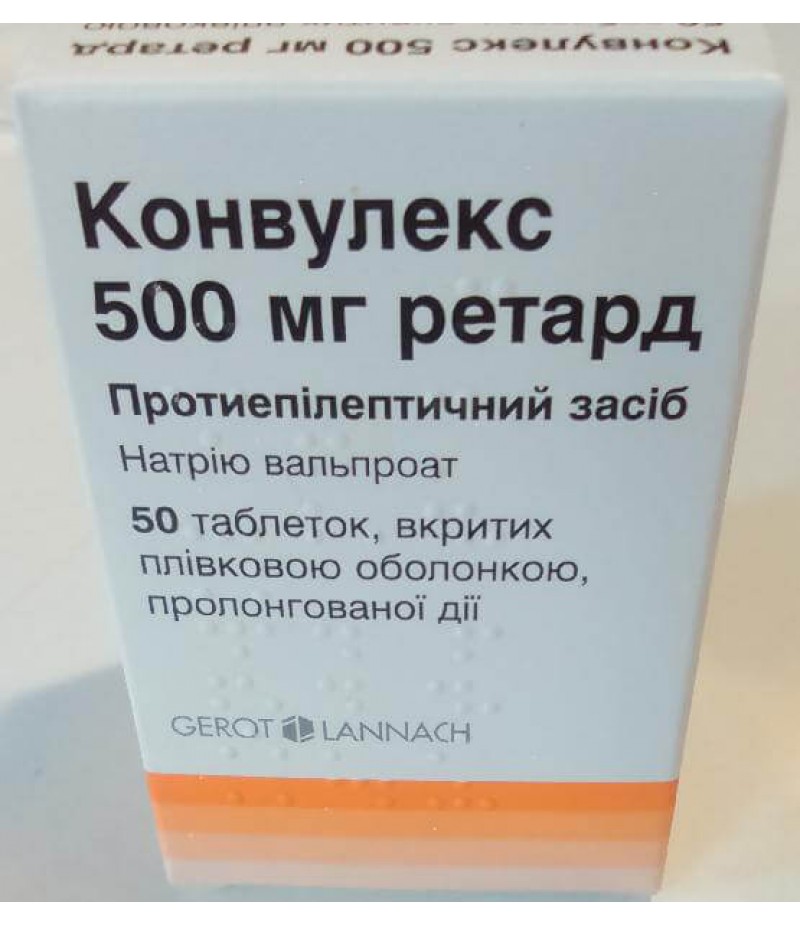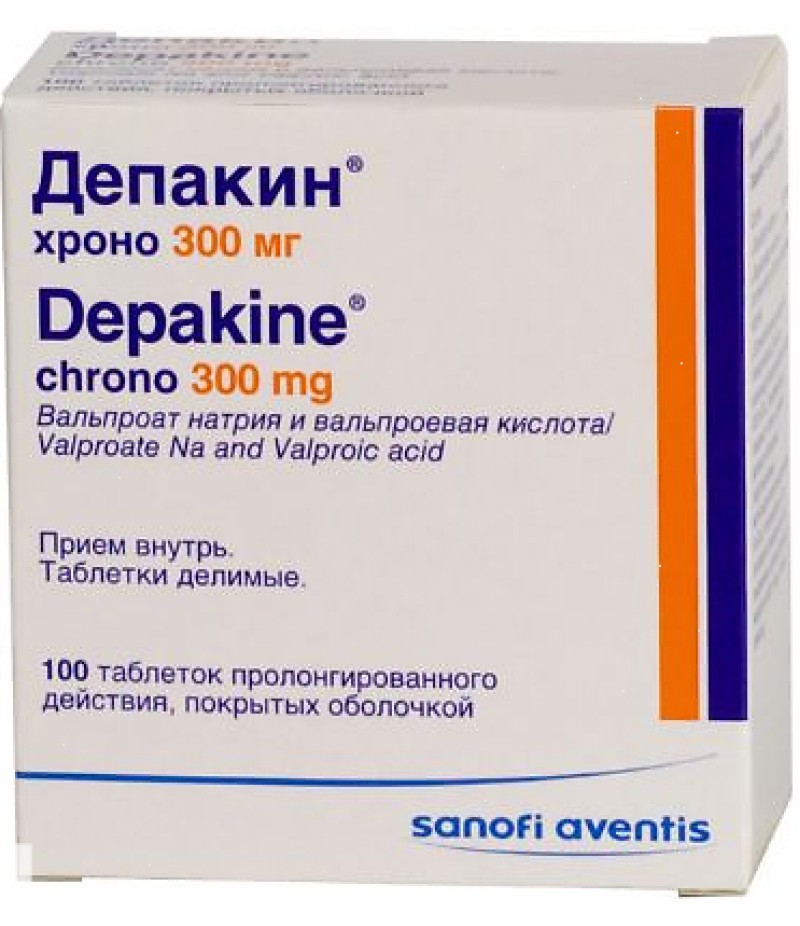Convulex tabs 500mg #50
- $32.90
- 3 or more $31.99
- Availability:In Stock
Instruction for ConvulexReed more and buy Convulex on this pageCompositionA 5 ml ampoule contains 500 mg of sodium valproate (corresponding to 433.9 mg of valproic acid).1 ml of syrup contains 50 mg of active substance. Syrup is i..
Tags: tabs
Instruction for Convulex
Reed more and buy Convulex on this page
Composition
A 5 ml ampoule contains 500 mg of sodium valproate (corresponding to 433.9 mg of valproic acid).
1 ml of syrup contains 50 mg of active substance. Syrup is intended for treatment in pediatrics, therefore it has a peculiar fruity smell. Additional components: sodium cyclamate, methyl parahydroxybenzoate, peach or raspberry flavor, sodium saccharinate, liquid maltitol.
The capsule contains 150, 300 or 500 mg of the active ingredient. Additional components: hydrochloric acid, hydrogenated starch, sorbitol, carion.
Form of issue
The medication is available in the form of a syrup (form for children), capsules, drops and solution.
Syrup and drops are available in 100 ml glass vials. In a pack of cardboard is 1 bottle and a special device for dosing.
Blister pack contains 10, 20 capsules. In a pack of cardboard for 5, 10 blisters.
The solution is produced in ampoules of 5 ml, packed in a polymer package with cells. In a pack of cardboard 5 ampoules each.
pharmachologic effect
An antiepileptic agent containing Na valproate. An anticonvulsant effect is provided by two mechanisms of action on the nervous system. The direct mechanism is based on an increase in the concentration of valproate in the nervous system; indirect - on modification of neurotransmitters, action on the membrane and cumulation of metabolites of the active substance.
Pharmacodynamics and pharmacokinetics
After taking valproate, an increase in the level of gamma-aminobutyric acid is recorded. Against the background of treatment, the period of the intermediate phase of sleep is shortened, and the time of slow sleep increases. The active ingredient is able to penetrate into breast milk, pass through both the hematoplacental barrier and the blood-brain barrier. The greatest concentration is noted in extracellular fluid and plasma. In the blood and cerebrospinal fluid, the same amount of valproate is deposited.
Binding to plasma proteins depends on the dose of the drug (80-95%). Metabolism of the active substance is carried out in the hepatic system. With hemodialysis, only the free fraction is excreted from the body. With pathology of the liver, the time for excretion of the drug slows down because of a low metabolism.
Indications for use
Medication is prescribed for all types of generalized seizures:
clonic;
tonic;
tonic-clonic.
The drug is used in the focal form of epilepsy (in the presence and absence of secondary generalization). In bipolar disorders and manic syndrome, valproic acid is also used.
In pediatric practice, to prevent recurrent febrile convulsions, the Convulex syrup is prescribed (with benzodiazepine therapy ineffective).
The solution is used for short-term therapy of epilepsy in individuals who, for certain reasons, can not take Convulex tablets.
Contraindications
porphyria;
pronounced pathology of the hepatic system, pancreas;
individual hypersensitivity;
severe thrombocytopenia (a drop in the number of platelets);
hemorrhagic diathesis.
With caution, valproic acid is prescribed for:
suppression of bone marrow hematopoiesis (anemia, leukopenia);
pathology of the renal system;
pancreatic diseases in the compensation phase;
with severe types of seizures (in pediatrics);
therapy with other antiepileptic medicines;
hypoproteinemia;
brain damage (organic forms);
congenital enzymopathies.
Side effects of Convulex (undesirable reactions)
Negative reactions are recorded with concomitant therapy and at a valproic acid concentration of more than 100 mg / l.
The digestive tract:
anorexia (or vice versa, increased appetite);
vomiting;
hepatitis;
gastralgia;
constipation;
nausea;
pancreatitis.
Nervous system:
ataxia;
dizziness;
coma;
impaired consciousness;
migraine headache;
drowsiness;
encephalopathy;
dysarthria;
stupor.
Rarely, the mood, style of behavior and mental state change in patients:
hallucinations;
fatigue;
depressed mood;
excitation;
psychosis;
hyperactive state;
irritability.
Endocrine system:
increased volume of mammary glands;
secondary form of amenorrhea;
dysmenorrhea;
galactorrhea.
Side effects from the senses:
nystagmus;
diplopia;
"Flies".
Less frequent are changes in the system of hemostasis, metabolism, allergic responses, alopecia (reversible reaction), peripheral edema.
Instructions for Convulex (Method and Dosage)
Syrup is taken per os during meals (allowed after meals). The kit includes a special measuring device, through which dosing is performed. The daily amount of valproic acid is recommended to be divided into 3 doses. The choice of doses is carried out taking into account the age, weight of the child and accompanying diseases. In the treatment of other medications aimed at arresting seizures, the dosage of Convulex is carried out for 15 days. Assessing the results of treatment, every 2 to 3 days, a dose adjustment with monotherapy is performed.
Capsules are intended for ingestion during meals (allowed after). It is inadmissible to open the capsules and grind them. The daily dose can be divided into 2 receptions. Dosing is carried out on an individual basis, titration is carried out during a month with complex therapy; with monotherapy - 7 days. The calculation of the daily dose is made according to the scheme: 10-15 mg / kg. Titration is carried out taking into account the plasma concentration of the active component in the blood, tolerance, the effectiveness of control over epiprids.
Instructions for the use of Convulex in the form of a solution: the medication is administered intravenously together with a special solvent or as bolus infusions. Ringer's solution can act as a solvent. The daily dose is calculated according to the scheme - 20-30 mg / kg.
Drops are prescribed 2-3 times a day during meals. The initial daily dose is 10/15 mg / kg. Then every 4 days the dose is increased by 200 mg.
Overdose
The symptomatology is manifested depending on the dose. In mild cases, there is drowsiness, nausea, dizziness, sedation. With severe intoxication, respiration is inhibited, hyporeflexia, metabolic acidosis, miosis, and hipponus develop. Rarely, edema of the brain and increased intracranial pressure. Assign enterosorbents, spend posindromnoj therapy.
Interaction
It is not recommended to prescribe medications that induce convulsions or reduce the convulsive threshold. It is unacceptable to prescribe neuroleptics, phenothiazinamines. Carbapenems, Azrethra and St. John's wort reduce the effectiveness of the medication, increasing the risk of seizures. Phenobarbital and carbamazepine lower the level of valproic acid. Convullex slows the excretion of Felbamate. It is necessary to warn the doctor about taking all medications before choosing a dose of valproic acid.
Storage conditions
Solar radiation destroys the structure of the solution and syrup. Temperature range: 15-25 degrees.
Shelf life
Capsules, solution and syrup can be stored for 5 years. Ready solution loses its effectiveness in a day.
Children
Prolonged tableted forms are contraindicated for children up to 3 years. In pediatric practice, a syrup is used.
During pregnancy (and lactation)
Anticonvulsant therapy with valproic acid suggests maximum protection from pregnancy. Experimental studies in animals have revealed a pronounced teratogenic effect of the active substance. In 2% of cases, defects in the development of the nervous system were registered in children who were born by women taking Convulex in the first trimester. Such patients are advisable the appointment of folic acid. With a high likelihood of developing seizures, doses of valproic acid are prescribed minimal, and other anticonvulsant medications are canceled. Control of valproic acid in the blood is mandatory.
Reviews of Convulex (the opinion of patients and doctors)
The drug is actively used in neurological practice to prevent epileptic attacks. Thematic portals contain a variety of patient reviews. Most of them describe all the negative symptoms that can accompany the course of anticonvulsant therapy. Situations are described when, unable to withstand adverse reactions, patients independently abolished the drug, after which the epileptic seizures again returned, changing the habitual style and lifestyle of patients.
In pediatric practice, neurologists prescribe the most accessible form of medication - the syrup for the children of Convulex. Parents' reviews confirm the high effectiveness of the drug in the treatment of epilepsy, because the number and severity of seizures is significantly reduced, despite the negative impact of valproic acid on children's mental abilities.



